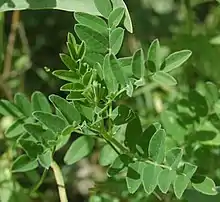| Astragalus mongholicus | |
|---|---|
 | |
| Scientific classification | |
| Kingdom: | Plantae |
| Clade: | Tracheophytes |
| Clade: | Angiosperms |
| Clade: | Eudicots |
| Clade: | Rosids |
| Order: | Fabales |
| Family: | Fabaceae |
| Subfamily: | Faboideae |
| Genus: | Astragalus |
| Species: | A. mongholicus |
| Binomial name | |
| Astragalus mongholicus Bunge[1] | |
| Synonyms[1] | |
| |
Astragalus mongholicus, synonyms including Astragalus propinquus and Astragalus membranaceus,[1] commonly known as Mongolian milkvetch in English;[2] 'Хунчир' in Mongolian; huáng qí (Chinese: 黃芪), běi qí (Chinese: 北芪) or huáng huā huáng qí (Chinese: 黃花黃耆),[3] in Mongolia, is a flowering plant in the family Fabaceae. It is one of the 50 fundamental herbs used in traditional Mongolian medicine.[4] It is a perennial plant and it is not listed as being threatened.[5]
Distribution
A. mongholicus is widespread in temperate Asia, being found in Kazakhstan, from Siberia to the Russian Far East, in Mongolia, and in west and north China.[1]
Herbalism
A. mongholicus is used in traditional Chinese medicine (TCM).[6] A. mongholicus is a component in Lectranal, a food supplement used in treatment of seasonal allergic rhinitis,[7] though there is limited evidence of its effectiveness.[8]
Chemistry
Chemical constituents of the roots (Radix Astragali) include polysaccharides and triterpenoids (such as astragalosides),[9] as well as isoflavones (including kumatakenin, calycosin, and formononetin) and their glycosides and malonates.[10] It contains the saponin cycloastragenol.
Toxicology
While several other species of Astragalus are known to cause severe poisonings in livestock due to indolizine alkaloids, aliphatic nitro compounds, and accumulated selenium,[11] none of these constituents have been detected in Astragalus mongholicus used in dietary supplements and TCM preparations.[12]
Compendial status
A. mongholicus is listed (as A. propinquus) in the following official pharmacopoeia:
- Japanese Pharmacopoeia[13]
See also
Notes and references
- 1 2 3 4 "Astragalus mongholicus Bunge". Plants of the World Online. Royal Botanic Gardens, Kew. Retrieved 2023-04-06.
- ↑ English Names for Korean Native Plants (PDF). Pocheon: Korea National Arboretum. 2015. p. 368. ISBN 978-89-97450-98-5. Archived from the original (PDF) on 25 May 2017. Retrieved 26 January 2017 – via Korea Forest Service.
- ↑ Joe Hing Kwok Chu. "Huang qi". Complementary and Alternative Healing University. Retrieved 2012-02-27.
- ↑ "Astragalus membranaceus – Moench". Plants for a Future.
- ↑ "Astragalus propinquus Schischkin". LegumeWeb. International Legume Database & Information Service. 2005-11-01. Retrieved 2012-02-27.
- ↑ Block, Keith I.; Mead, Mark N. (1 September 2003). "Immune System Effects of Echinacea, Ginseng, and Astragalus: A Review". Integrative Cancer Therapies. 2 (3): 247–267. doi:10.1177/1534735403256419. PMID 15035888.
- ↑ Matkovic Z, Zivkovic V, Korica M, Plavec D, Pecanic S, Tudoric N (2010). "Efficacy and safety of Astragalus membranaceus in the treatment of patients with seasonal allergic rhinitis". Phytother Res. 24 (2): 175–81. doi:10.1002/ptr.2877. PMID 19504468. S2CID 46201817.
- ↑ Guo, Ruoling; Pittler, Max H.; Ernst, Edzard (December 2007). "Herbal medicines for the treatment of allergic rhinitis: a systematic review". Annals of Allergy, Asthma & Immunology. 99 (6): 483–495. doi:10.1016/S1081-1206(10)60375-4. PMID 18219828.
- ↑ Xu, Q.; Ma, X.; Liang, X. (2007). "Determination of Astragalosides in the Roots of Astragalus spp. Using Liquid Chromatography Tandem Atmospheric Pressure Chemical Ionization Mass Spectrometry". Phytochemical Analysis. 18 (5): 419–427. doi:10.1002/pca.997. PMID 17624885.
- ↑ Lin, L. Z.; He, X. G.; Lindenmaier, M.; Nolan, G.; Yang, J.; Cleary, M.; Qiu, S. X.; Cordell, G. A. (2000). "Liquid Chromatography-Electrospray Ionization Mass Spectrometry Study of the Flavonoids of the Roots of Astragalus mongholicus and A. membranaceus". Journal of Chromatography A. 876 (1–2): 87–95. doi:10.1016/S0021-9673(00)00149-7. PMID 10823504.
- ↑ Rios, J. L.; Waterman, P. G. (1997). "A review of the pharmacology and toxicology of Astragalus". Phytotherapy Research. 11 (6): 411–418. doi:10.1002/(SICI)1099-1573(199709)11:6<411::AID-PTR132>3.0.CO;2-6. S2CID 84850794.
- ↑ "Astragalus". WebMD.
- ↑ Japanese Pharmacopoeia (PDF) (15th ed.). Archived from the original (PDF) on 2011-07-22.
External links
- "Astragalus membranaceus – Moench". Plants for a Future.
- "Astragalus membranaceus (FISCH. EX LINK) BUNGE – Fabaceae". Dr. Duke's Phytochemical and Ethnobotanical Databases. ARS / GRIN. Archived from the original on 2004-11-15.